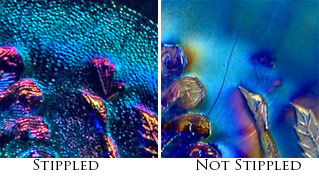Coin Spot
By Dr. Larry Keig
Coin Spot is a simple pattern of interest to stretch as well as carnival collectors. The stretch Coin Spot usually attracts the lion’s share of attention and command higher prices than those with typical carnival Finishes.
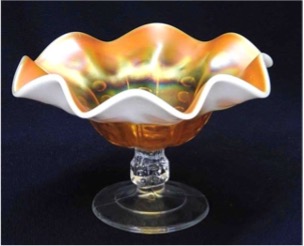
The peach opal is a common Coin Spot color. These can be very pretty, as the illustrated example is, or pretty awful. (Photo courtesy of Seeck Auctions.)
The pattern is named for the design on its underside and stem. It is there where the sixteen alternating oblong coined and arched unpatterned columns are found pressed into the surface. The six coins on each column of the container are larger than the coin that connects the receptacle to the bulb just above the base. The interior surface is plain.
Two versions of the pattern are available. One has textured (or stippled) coins. The coins on the other are plain (non-textured). The stretch items usually (maybe always) have textured coins. The coins on those with satin finish are more often than not smooth.
Three shapes are available. Flared compotes are by far the commonest shape. Parfaits and goblets are seen only occasionally.
Made by both Dugan and Diamond, Coin Spot appeared in industry catalogs until the glassmaking plant closed in 1931. The pattern’s long life helps account for the large number of colors manufactured.
The names of Dugan-Diamond’s Coin Spot (or Thumbprints, as Tom Burns refers to it), Fenton’s Coin Dot, and Westmoreland’s Pearly Dots are often misapplied. Coin Spot is easily distinguished from these other patterns by the intaglio coins on the reverse of the vessel and stem in combination with the unpatterned interior.
Russell and Kitty Umbraco have written an informative piece on Coin Spot from a stretch glass perspective. It appeared in the November 21, 2017, “Stretch Glass Tuesday” issue of the HOC Mailing List. (Here is the link: Stretch Glass Tuesday 11-21-17)
Compotes
The widely flared eight-ruffled compotes have top diameters ranging from five and one-half to six and one-half inches. They stand from four to four and one-half inches tall. The coin at the top of each patterned column and the arches of the plain columns are often partially obscured and distorted by the ruffling, if visible at all, especially on those with the widest top diameters.
Flared compotes are available in an extraordinarily wide range of colors. The vivid colors with satin finish reported are marigold, peach opal, amethyst/purple, cobalt blue, and Egyptian Lustre, an opaque deep purple made by Diamond in the early – to mid – 1920s. The marigold, peach opal, and amethyst are available. The non-stretch cobalt is harder to find. The Egyptian Lustre is nearly impossible to track down. Aqua opal and non-fluorescent vaseline are also said to exist.
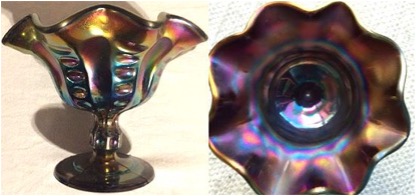
Diamond’s Egyptian Lustre is a nearly opaque deep purple. Compotes in this color are hard to find. (Photo courtesy of Kitty and Russell Umbraco)
Two widely acknowledged iridescent After Glow colors are known: pink (rose shimmering) and lime green (green shimmering), both with marigold overlay.* A third, in effect an After Glow, is a light amber also with marigold overlay. All are products of the late Diamond years.
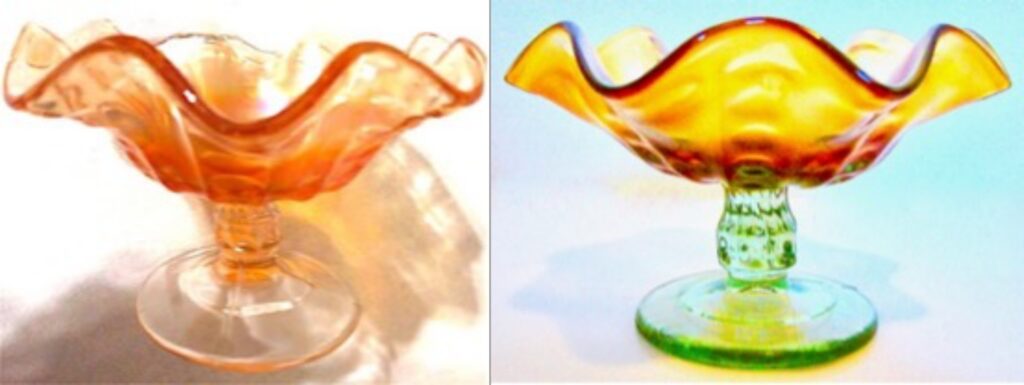
The pink and green After Glow, above, are available. The marigold over amber, below, is a difficult color to come by. (The illustrated marigold over green is courtesy of Barb Chamberlain; the pictured After Glow pink and amber are courtesy of the Umbracos)
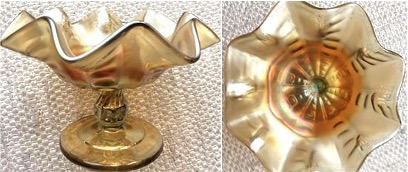
Four pastels and two vivids in stretch have been confirmed. In addition to the easily recognized and desirable celeste (Harding blue) and ice green (ice green lustre) are the white (pearl lustre) reported by Samantha Prince and Russell and Kitty Umbraco and the fluorescent vaseline (topaz), also reported by the Umbracos. The two confirmed vivids in stretch are a cobalt blue (blue crackle) and a darker-than-amethyst medium purple (twilight wisteria). All six are likely products of the late teens or early- to mid- ’20’s.*
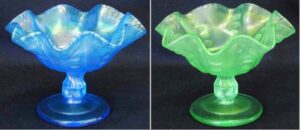
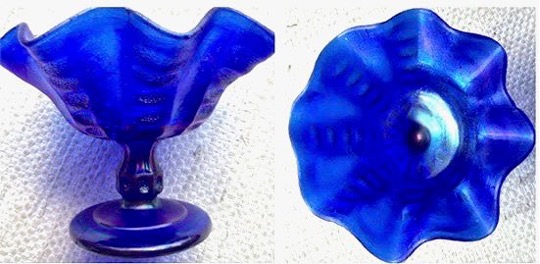
A vivid stretch “blue crackle” is also seen from time to time. (Photo courtesy of the Umbracos.)
Samantha Prince described and pictured a stretchy white Coin Spot souvenir in the January 18, 2018, issue of the HOC Mailing List. Its hand-written lettering reads “Souvenir/Indiana Fair/’22.” The event referred to is almost certainly the county fair at Indiana, Pennsylvania, then and now a small town** near Pittsburgh where the Dugan and Diamond plant operated. The Eberly College of Business building on the Indiana University of Pennsylvania (IUP) campus now stands near the site of the former glass factory.***
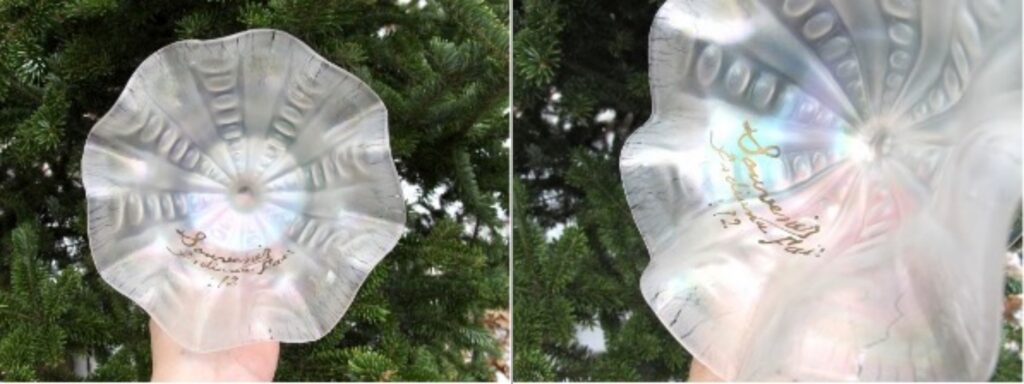
A notable observation about this white compote is its date of manufacture. Until recently, it was thought that the production of white carnival had been confined to the Dugan years with some spillover into the early Diamond era. But with this dated piece, we now know that production of white iridescent glass extended at least a decade beyond that or that the color was re-introduced in stretch glass in the 1920s.
Sidebar. Two Band items with “Indiana Fair” hand lettering have also been reported. One is a small marigold basket with a clear crystal handle fused to a hat shape. The other is an amethyst hat owned by Mike Carwile and pictured at the Carnival Glass Showcase website. The former is dated 1924; Carwile’s, 1925.
Parfaits
The parfait is a compote with essentially straight-up, rather than flared, sides. Although larger, it resembles in shape the Cambridge Inverted Feather parfait.
On the parfait, all six coins on the bowl and the arches atop each unpatterned column are clearly visible below the ruffled top. The coins are plain (non- stippled).
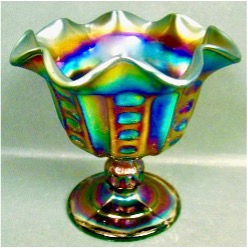
Reported only in amethyst, the Coin Spot parfait has straight-up rather than flared sides. (Photo courtesy of Burns auctions.)
All reported parfaits are amethyst/purple. The illustrated example measures five and one-half inches across the top and stands five and one-fourth inches tall. It sold at the 2018 NECGA (Burns) convention auction. One other is recorded as having sold. Pictured at the Coin Spot page of the HOC Carnival Pricing Database, it changed hands at a Seeck online auction in December 2014. Yet another is illustrated in Carl O. Burns’s Dugan and Diamond Carnival Glass book (p.51).
Goblet
The so-called goblet is the Coin Spot proof. As such, it is the shape from which the compotes and parfaits were derived.
All reported goblets are in a stretch ice green, and all have the textured coins. The illustrated goblet is David Kastor’s. It measures three and seven-eighth inches across the top and stands five inches tall.It is surprising that the goblets have been reported only in ice green, as this color was first produced in the late teens, well after the firm was restructured as the Diamond Glass Company. It is baffling in a way that no proofs from the Dugan years (1909-1913), when vast quantities of Coin Spot compotes were made, have surfaced. Or have they?
The goblet is the premiere piece in the Coin Spot pattern.
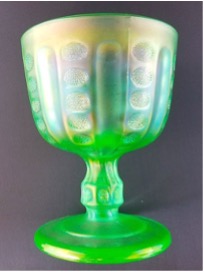
The goblet is the proof in the Coin Spot pattern and the most desirable of the shapes. (Photo courtesy of David Kastor)
Notes
*Colors listed in parentheses are the stretch glass equivalents of the carnival glass colors preceding them. The Shetlar Stretch Glass website is an excellent source, with information on Diamond colors.
**According to the U.S. Census, the population of Indiana, Pennsylvania, was 5,749 in 1910, 7,043 in 1920, and 9,569 in 1930. Its population peaked at 16,051 in 1980. It stood at 13,975 in the 2010 census.
***Harrison Wick, a reference librarian at Indiana University of Pennsylvania, provided valuable content for this article.
This article first appeared in the ICGA Pump in the December 2018 issue and is reprinted with permission.

